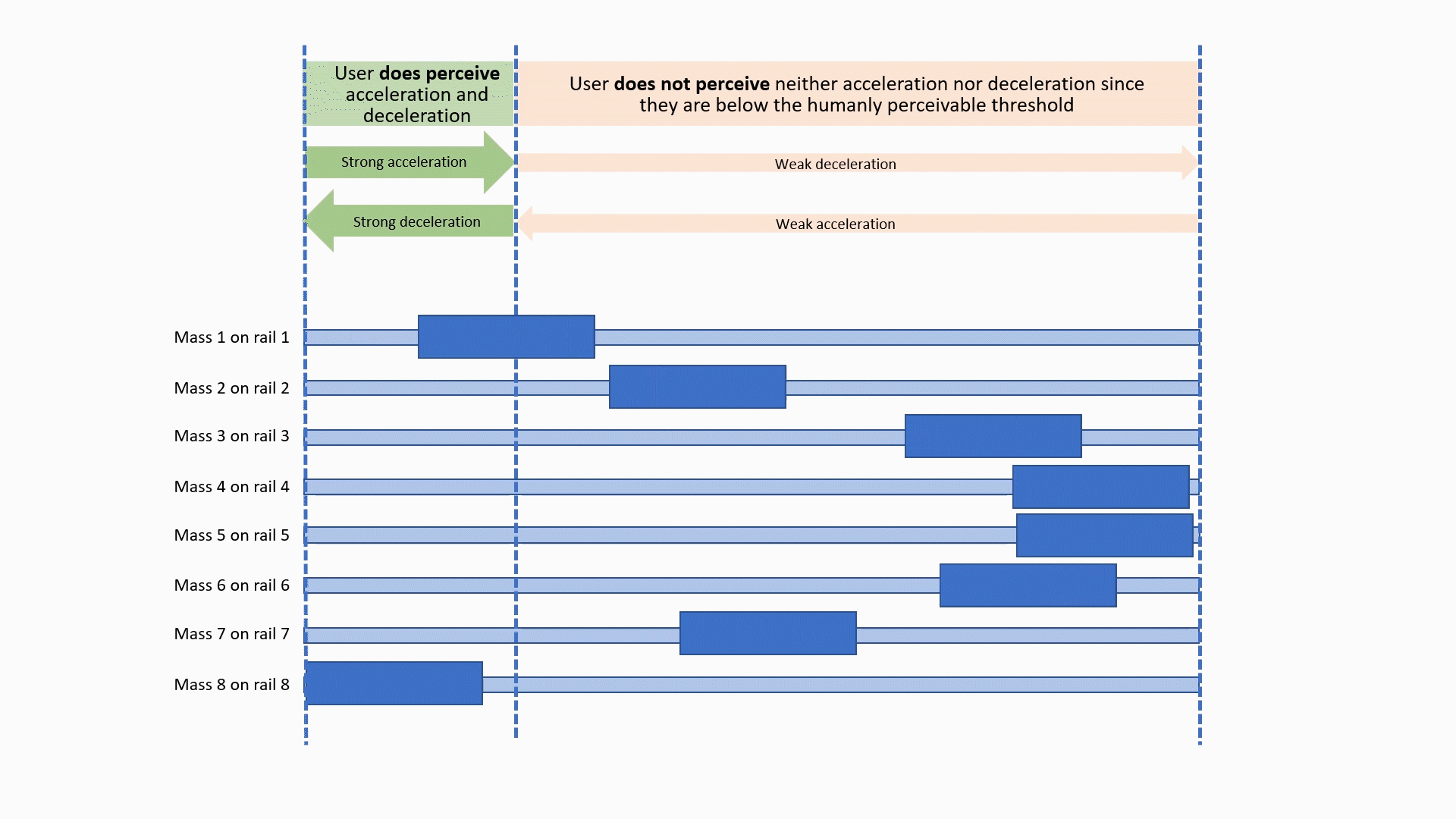Nudging Headphones
Project developed at: Harman International
This project was about providing non-visual, non auditory navigation or movement “sensations” to the user. More specifically, the project explored ways to provide the user with subtle sensations of being "pushed" or "pulled" in specific directions. These effects can feel almost subconscious and have potential applications in headphones, smart earbuds (Hearables), AR/VR/XR devices, and other wearables. Use cases include pedestrian navigation, directional warnings, gaming, and immersive AR/VR experiences.
We developed and tested three distinct methods to achieve this effect:
Dynamic Weight Shifting: Mechanically or pneumatically adjusting the center of gravity in headphones to create directional sensations. This approach is straightforward, effective, and suitable for productization.
Linear Asymmetric Acceleration: Leveraging the movement of small masses with asymmetric acceleration to generate directional fictitious forces. This method delivers an extraordinary and unique sensation but involves complex mechanical components.
Miniaturized Air Propulsion: Using small fans or jets to create airflows that nudge the user in a particular direction. This includes technologies such as axial fans, ducted fans, micro turbines, and MEMS-based propulsion systems.
These methods were patented, with two patents already granted, showcasing their potential for innovative product development.
Patents:
This image illustrates the first method, which dynamically shifts the center of gravity (CoG) in a headphone or headset device (such as an AR/VR device). This effect is achieved either by redistributing fluids between small containers on the user's head or by mechanically moving weights along rails or hinges.
The result is a subtle imbalance that the user perceives through their vestibular sense (inner ear balance), prompting them to turn their head or body to restore balance. This gentle nudge creates an alternative, non-visual, and non-auditory communication channel between the device and the user.
Applications for this method include:
Pedestrian Navigation: Guiding the user toward an intended direction.
Directional Alerts: Drawing attention to a source of danger or point of interest.
Virtual Personal Assistants: Focusing the user’s attention subtly without disrupting their environment.
The required forces are minimal and can be subtle enough to be subconsciously perceived. While the illustrated prototypes are exaggerated for clarity, a product version would feature hidden, miniaturized actuators.
Company: Harman International
Team: Future Experience Team
Location: Palo Alto, CA
Year: 2014-2016
This image shows early exploration prototypes for head-mounted ungrounded force actuators, each utilizing a distinct method. These prototypes were rapidly developed to directly test user experience, as the perception of such unique forces is difficult to simulate, describe or imagine, but becomes clear through hands-on experience.
This animation illustrates the concept behind the second method, which creates the sensation of a continuous unidirectional force using asymmetric linear acceleration of multiple small masses on parallel rails. The system generates strong acceleration and deceleration in the desired direction over a brief period (perceptible as force) while using weaker, slower motions in the opposite direction, which fall below human perception thresholds.
By synchronizing the motion of multiple masses with slightly different phase timings, the system produces the illusion of a constant "push" or "pull" in a single direction. Because humans more strongly feel rapid acceleration than slow acceleration (due to the sensitivity of the human vestibular system) , in our system people only perceive the force in one direction and not the movement to return the weights in the original position, due to the asymmetric acceleration/deceleration cycles.
Applications include creating directional cues for navigation, alerts, or immersive AR/VR experiences. While the illustrated prototype demonstrates the effect along a single axis, the system can be extended to 2D or 3D space for more versatile interactions.
This patented system avoids unpleasant sensations like vibrations or intermittent poking by maintaining asymmetric motion cycles and distributing the effect across multiple masses. The principles underlying this method have been described in scientific publications referenced in the patent.
This image illustrates the third method, which uses air or gas flow to generate directional forces on the user’s head. The concept is straightforward but has been refined into sophisticated designs, as detailed in the team’s granted patent.
Top Row: Simple prototypes use ducted fans attached to headgear, such as headphones. These CAD models depict oversized fans for clarity, but a product would feature miniaturized and relatively quiet fans or MEMS turbines. Even with smaller components, the generated forces are sufficient for the user to perceive directional feedback.
Bottom Row, Left: Patent illustrations show assemblies of ducted fans and the forces they exert. Some designs use panning/tilting fans or thrust-vectoring vanes to control force direction.
Bottom Row, Middle: One practical embodiment attaches a micro quadcopter-like system to headphones, providing four degrees of freedom (roll, pitch, yaw, and vertical linear motion). Protective casing for the propulsion system would ensure user safety.
Bottom Row, Right: Additional designs place propulsion units on shoulders, wrists, or belts, offering unique degrees of freedom for diverse applications. These embodiments are shown oversized for clarity.
The patent also addresses challenges like thermal and noise management. Solutions include active noise cancellation (ANC) for ducted fans and alternatives like micro jets powered by compressed air, which reduce the need for moving parts.



